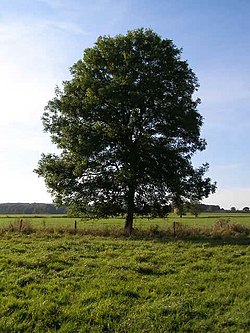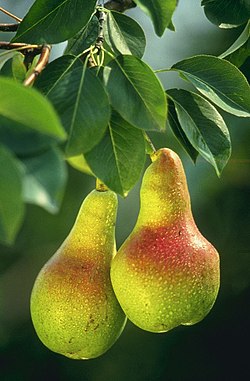Portal:Trees
The Trees Portal

In botany, a tree is a perennial plant with an elongated stem, or trunk, usually supporting branches and leaves. In some usages, the definition of a tree may be narrower, e.g., including only woody plants with secondary growth, only plants that are usable as lumber, or only plants above a specified height. Wider definitions include taller palms, tree ferns, bananas, and bamboos.
Trees are not a monophyletic taxonomic group but consist of a wide variety of plant species that have independently evolved a trunk and branches as a way to tower above other plants to compete for sunlight. The majority of tree species are angiosperms or hardwoods; of the rest, many are gymnosperms or softwoods. Trees tend to be long-lived, some trees reaching several thousand years old. Trees evolved around 400 million years ago, and it is estimated that there are around three trillion mature trees in the world currently.
A tree typically has many secondary branches supported clear of the ground by the trunk, which typically contains woody tissue for strength, and vascular tissue to carry materials from one part of the tree to another. For most trees the trunk is surrounded by a layer of bark which serves as a protective barrier. Below the ground, the roots branch and spread out widely; they serve to anchor the tree and extract moisture and nutrients from the soil. Above ground, the branches divide into smaller branches and shoots. The shoots typically bear leaves, which capture light energy and convert it into sugars by photosynthesis, providing the food for the tree's growth and development.
Trees usually reproduce using seeds. Flowering plants have their seeds inside fruits, while conifers carry their seeds in cones, and tree ferns produce spores instead.
Trees play a significant role in reducing erosion and moderating the climate. They remove carbon dioxide from the atmosphere and store large quantities of carbon in their tissues. Trees and forests provide a habitat for many species of animals and plants. Tropical rainforests are among the most biodiverse habitats in the world. Trees provide shade and shelter, timber for construction, fuel for cooking and heating, and fruit for food as well as having many other uses. In much of the world, forests are shrinking as trees are cleared to increase the amount of land available for agriculture. Because of their longevity and usefulness, trees have always been revered, with sacred groves in various cultures, and they play a role in many of the world's mythologies. (Full article...)

Brachychiton rupestris (commonly known as the narrow-leaved bottle tree or Queensland bottle tree) is a tree in the family Malvaceae, endemic to Queensland, Australia. Described by Sir Thomas Mitchell and John Lindley in 1848, it earned its name from its bulbous trunk, which can be up to 3.5 metres (11 ft) in diameter at breast height (DBH). Reaching around 10–25 m (33–82 ft) high, the Queensland bottle tree is deciduous, losing its leaves seasonally, between September and December. The leaves are simple or divided, with one or more narrow leaf blades up to 11 centimetres (4 in) long and 2 cm (0.8 in) wide. Cream-coloured flowers appear from September to November, and are followed by woody, boat-shaped follicles that ripen from November to May. No subspecies are recognised.
As a drought deciduous succulent tree, much like the baobab (Adansonia) of Madagascar, B. rupestris adapts readily to cultivation, and is quite tolerant of a range of soils and temperatures. It is a key component and emergent tree in the endangered central semi-evergreen vine thickets (also known as bottletree scrub) of the Queensland Brigalow Belt. Remnant trees are often left by farmers on cleared land for their value as shade and fodder trees, and as homes for various birds and animals. (Full article...)
Did you know? -
- ... that a fellow artist said of Allen Butler Talcott that "no one was his peer in the knowledge of trees and how to paint them" (painting of oak pictured)?
- ... that sex scenes in the controversial 1967 film I Am Curious (Yellow) were shot inside the Rumskulla oak, an oak tree that is more than 1,000 years old?
- ... that the red nose-like structure of the cherrynose cicada contains muscles that help it suck xylem out of trees?
- ... that extracts from leaves of the mahogany tree suren toon are used as antibacterial poultices?
- ... that The Greening of Detroit has planted over 81,000 trees in the Michigan city since the organization's inception in 1989?
- ... that the vinhática tree Plathymenia reticulata (pictured), provides the preferred timber for making dugout canoes in Brazil, because it is resistant to rotting?
Selected article -
Pears are fruits produced and consumed around the world, growing on a tree and are harvested in late summer into mid-autumn. The pear tree and shrub are a species of genus Pyrus /ˈpaɪrəs/, in the family Rosaceae, bearing the pomaceous fruit of the same name. Several species of pears are valued for their edible fruit and juices, while others are cultivated as trees.
The tree is medium-sized and native to coastal and mildly temperate regions of Europe, North Africa, and Asia. Pear wood is one of the preferred materials in the manufacture of high-quality woodwind instruments and furniture. (Full article...)
General images
Selected lists
Subcategories
Related portals
Associated Wikimedia
The following Wikimedia Foundation sister projects provide more on this subject:
-
Commons
Free media repository -
Wikibooks
Free textbooks and manuals -
Wikidata
Free knowledge base -
Wikinews
Free-content news -
Wikiquote
Collection of quotations -
Wikisource
Free-content library -
Wikispecies
Directory of species -
Wikiversity
Free learning tools -
Wiktionary
Dictionary and thesaurus








































































